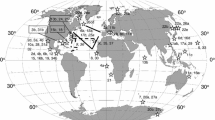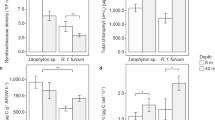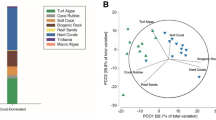Abstract
Rates of ammonia excretion, and respiration to excretion (atomic O:N) ratios were measured for three species of scleractinian coral from the Bahamas, during August 1986 and March 1987, to test the hypothesis that zooxanthellate reef species have lower rates of amino acid catabolism and higher dependence on lipid and carbohydrate catabolism than nonzooxanthellate species. Freshly collected individuals of two reef species,Montastrea annularis andAcropora cervicornis, have significantly lower mean ammonia excretion rates [51 ± 66 nmol (mg-at N)−1 h−1 and 192 ± 172 nmol (mg-at N)−1 h−1, respectively] than those of the tropical nonzooxanthellate speciesTubastrea coccinea [257 ± 68 nmol (mg-at N)−1 h−1]. The temperate nonzooxanthellate coralAstrangia poculata has mean excretion rates [632 ± 242 nmol (mg-at N)−1 h−1] which are much higher than those of all three tropical species. O:N ratios for the two reef species were generally greater than 300, while those of the nonzooxanthellate species ranged from 17 to 39 forT. coccinea and from 8 to 12 forA. poculata. The two reef species conserve nitrogen by having relatively low rates of amino acid catabolism, and support most of their metabolic needs by catabolizing the lipids and carbohydrates they receive from their zooxanthellae. The tropical nonzooxanthellate species has lower rates of ammonia excretion and respiration, and higher O:N ratios than the temperate nonzooxanthellate coral, which may be an indication that the former has less food available to it. The ammonia production rates of the reef species would support doubling times (growth rates) of the zooxanthellae of 13 to 22 d. These growth rates agree with observed rates obtained by mitotic index methods, and with suggestions that growth of zooxanthellae within many corals may be nitrogen-limited.
Similar content being viewed by others
Literature cited
Baldwin, E. (1964). An introduction to comparative biochemistry. 4th ed Cambridge University Press, Cambridge, England
Båmstedt, U. (1985). Seasonal excretion rates of macrozooplankton from the Swedish west coast. Limnol. Oceanogr. 30: 607–617
Battey, J. F., Patton, J. S. (1984). A reevaluation of glycerol in carbon translocation in zooxanthellae-coelenterate symbiosis. Mar. Biol. 79: 27–38
Battey, J. F., Patton, J. S. (1987). Glycerol translocation inCondylactis gigantea. Mar. Biol. 95: 37–46
Bayne, B. L., Scullard, C. (1977). Rates of nitrogen excretion by species ofMytilus (Bivalvia: Mollusca). J. mar. biol. Ass. U.K. 57: 5–369
Boucher-Rodoni, R., Mangold, K. (1985). Ammonia excretion during feeding and starvation inOctopus vulgaris. Mar. Biol. 86: 193–197
Campbell, J. W. (1973). Nitrogen excretion. In: Prosser, C. L. (ed.) Comparative animal physiology. 3rd ed. W. B. Saunders, Philadelphia, p. 279–316
Cook, C. B., D'Elia, C. F. (1987). Are natural populations of zooxanthellae ever nutrient limited? Symbiosis 4: 199–212
Cook, C. B., D'Elia, C. F., Muller-Parker, G. (1988). Host feeding and nutrient sufficiency for zooxanthellae in the sea anemoneAiptasia pallida. Mar. Biol. 98: 253–262
Droop, M. R. (1963). Algae and invertebrates in symbiosis. Symp. Soc. gen. Microbiol. 13: 171–199
Ferrer, L. M., Szmant, A. M. (1988). Nutrient regeneration by the endolithic community in coral skeletons. Proc. 6th int. Symp. coral Reefs (in press). [Choat, J. H. et al. (eds.) Sixth International coral Reef Symposium Executive Committee, Townsville, Australia]
Fitt, W. K., Pardy, R. L. (1981). Effects of starvation, and light and dark on the energy metabolism of symbiotic and aposymbiotic sea anemones,Anthopleura elegantissima. Mar. Biol. 61: 199–205
FitzGerald, L. M., Szmant, A. M. (1988). Amino acid metabolism: adaptations to low nutrient conditions? Proc. 6th int. Symp. coral Reefs (in press). [Choat, J. H. et al. (eds.) Sixth International Coral Reef Symposium Executive Committee, Townsville, Australia]
Froelich, A. S. (1980). Studies of the reproduction, nutrition and symbiosis with zooxanthellae of the temperate scleractinian coralAstrangia danae. Ph.D. dissertation, University of Rhode Island
Gladfelter, E. H., Monahan, R. K., Gladfelter, W. B. (1978). Growth rates of five reef-building corals in the northeastern Caribbean. Bull. mar. Sci. 28: 728–734
Hull, C. H., Nie, N. H. (1981). SPPS update. 7–9: new procedures and facilities for releases 7–9. McGraw Hill Book Co., New York
Ikeda, T. (1972). Nutritional ecology of marine zooplankton. Mem. Fac. Fish. Hokkaido Univ. 22: 1–97
Ikeda, T., Mitchell, A. W. (1982). Oxygen uptake, ammonia excretion and phosphate excretion by krill and other Antarctic zooplankton in relation to body size and chemical composition. Mar. Biol. 71: 283–298
Johannes, R., Wiebe, W. (1970). Method for determination of coral tissue biomass and composition. Limnol. Oceanogr. 15: 822–824
Kawaguti, S. (1953). Ammonium metabolism of the reef corals. Biol. J. Okayama Univ. 1: 171–176
Kremer, P. (1982). Effects of food availability on the metabolism of the ctenophoreMnemiopsis mccradyi. Mar. Biol. 71: 149–156
Kremer, P., Canino, M. F., Gilmer, R. W. (1986). Metabolism of epipelagic tropical ctenophores. Mar. Biol. 90: 403–412
Lee, R. F., Hirota, J. (1973). Wax esters in tropical zooplankton and nekton and the geographical distribution of wax esters in marine copepods. Limnol. Oceanogr. 18: 227–239
Marsh, J. A. (1970). Primary productivity of reef-building calcareous and red algae. Ecology 51: 255–263
Muscatine, L. (1967). Glycerol excretion by symbiotic algae from corals andTridacna and its control by the host. Science, N.Y. 156: 516–519
Muscatine, L. (1974). Endosymbiosis of cnidarians and algae. In: Muscatine, L. H. M. Lenhoff, (eds.) Coelenterate biology. Academic Press, New York, p. 359–395
Muscatine, L., D'Elia, C. F. (1978). The uptake, retention and release of ammonium by reef corals. Limnol. Oceanogr. 23: 725–734
Muscatine, L., Falkowski, P. G., Porter, J. W., Dubinsky, Z. (1984). Fate of photosynthetic fixed carbon in light- and shade-adapted colonies of the symbiotic coralStylophora pistillata. Proc. R. Soc. (Ser. B) 222: 181–202
Muscatine, L., Lenhoff, H. M. (1965) Symbiosis of hydra and algae. II. Effects of limited food and starvation on growth of symbiotic and aposymbiotic hydra. Biol. Bull. mar. biol. Lab., Woods Hole 129: 316–328
Muscatine, L., Marian, R. E. (1982). Dissolved inorganic nitrogen flux in symbiotic and nonsymbiotic medusae. Limnol. Oceanogr. 27: 910–927
Muscatine, L., Masuda, H. and Burnap, R. (1979). Ammonium uptake by symbiotic and aposymbiotic reef corals. Bull. mar. Sci. 29: 572–575
Patton, J. S., Burris, J. E. (1983). Lipid synthesis and extrusion by freshly isolated zooxanthellae (symbiotic algae). Mar. Biol. 75: 131–136
Peters, E. C., Cairns, S. D., Pilson, M. E. Q., Wells, J. W., Japp, W. C., Lang, J. C., Valeski, C. E., Gollahon, L. S. (1988). Nomenclature and biology ofAstrangia poculata. Proc. biol. Soc. Wash. 101: 234–250
Pomeroy, L. R., Kuenzler, E. J. (1969). Phosphorus turnover by coral reef animals. Proc. 2nd natn. Symp. Radioecol. (Ann Arbor, 1967). 2: 474–482. (Copies available from: National Technical Service, U.S. Department of Commerce, Springfield, Va 22161, USA; Ref. AEC-CONF-670503)
Porter, J. W. (1974). Zooplankton feeding by the Caribbean reefbuilding coralMontastrea annularis. Proc. 2nd int. Symp. coral Reefs 1: 111–125. [Cameron, A. M. et al. (eds.) Great Barrier Reef Committee, Brisbane, Australia]
Porter, J. W. (1976). Autotrophy, heterotrophy and resource partitioning in Caribbean reef corals. Am. Nat. 110: 731–742
Quetin, L. B., Ross, R. M., Uchio, K. (1980). Metabolic characteristics of mid water zooplankton: ammonia excretion, O:N ratios, and the effect of starvation. Mar. Biol. 59: 201–209
Reimer, A. A. (1971). Observations on the relationships between several species of tropical zoanthids (Zoanthidea, Coelenterata) and their zooxanthellae. J. exp. mar. Biol. Ecol. 7: 207–214
Slawyk, G., MacIsaac, J. J. (1972). Comparison of two automated ammonia methods in a region of coastal upwelling. Deep-Sea Res. 19: 521–524
Steele, R. D. (1975). Stages in the life history of a symbiotic zooxanthella in pellets extruded by its hostAiptasia tagetes (Duch. and Mich.) (Coelenterata: Anthozoa). Biol. Bull. mar. biol. Lab., Woods Hole 149: 590–600
Steele, R. D. (1976). Light intensity as a factor in the regulation of the density of symbiotic zooxanthellae inAiptasia tagetes (Coelenterata, Anthozoa). J. Zool., Lond. 179: 387–405
Steele, R. D., Goreau, N. I. (1977). The breakdown of symbiotic zooxanthellae in the sea anemonePhylactis (=Qulactis)flosculifera (Actiniaria). J. Zool., Lond. 181: 421–437
Syrett, P. J. (1981). Nitrogen metabolism of microalgae. In: Platt, T. (ed.) Physiological bases of phytoplankton ecology. Can. Bull. Fish. aquat. Sciences 210: 182–210
Szmant-Froelich, A., Johnson, A. V., Hoehn, T., Battey, J., Smith, G. J., Fleischmann, E., Porter, J. W., Dallmeyer, D. (1981). The physiological effects of oil drilling mud on the Caribbean coralMontastrea annularis. Proc. 4th int. Symp. coral Reefs 1: 163–168. [Gomez, E. D. et al. (eds.) Marine Sciences Center, University of the Philippines, Quezon City]
Szmant-Froelich, A., Pilson, M. E. Q. (1977). Nitrogen excretion by colonies of the temperate coralAstrangia danae with and without zooxanthellae. Proc. 3rd int. Symp. coral Reefs 1: 417–424. [Taylor, D. L. (ed.) School of Marine and Atmospheric Sciences, University of Miami]
Szmant-Froelich, A., Pilson, M. E. Q. (1984). Effects of feeding frequency and symbiosis with zooxanthellae on nitrogen metabolism and respiration of the coralAstrangia danae. Mar. Biol. 81: 153–162
Verity, P. G. (1985). Ammonia excretion rates of oceanic copepods and implications for estimates of primary production in the Sargasso Sea. Biol. Oceanogr. 3: 249–282
Wilkerson, F. P., Kobayashi, D., Muscatine, L. (1988). Mitotic index and size of symbiotic algae in Caribbean reef corals. Coral Reefs 7: 29–36
Wilkerson, F. P., Muscatine, L. (1984). Uptake and assimilation of dissolved inorganic nitrogen by a symbiotic sea anemone. Proc. R. Soc. (Ser. B) 221: 71–86
Wilkerson, F. P., Trench, R. K. (1986). Uptake of dissolved inorganic nitrogen by the symbiotic clamTridacna gigas and the coralAcropora sp. Mar. Biol. 93: 237–246
Yamazato, K. (1970). Calcification in a solitary coral,Fungia scutaria Lamarck, in relation to environmental factors. Bull. Sci. Eng Div. Univ. Ryukyus Math (Naha, Okinawa) (Math. nat. Sciences) 13: 57–122
Yonge, C. M., Nicholls, A. G. (1931). Studies on the physiology of corals. IV. The structure, distribution and physiology of the zooxanthellae. Scient. Rep. Gt Barrier Reef Exped. 1: 135–176
Author information
Authors and Affiliations
Additional information
Communicated by J. M. Lawrence, Tampa
Rights and permissions
About this article
Cite this article
Szmant, A.M., Ferrer, L.M. & FitzGerald, L.M. Nitrogen excretion and O:N ratios in reef corals: Evidence for conservation of nitrogen. Mar. Biol. 104, 119–127 (1990). https://doi.org/10.1007/BF01313165
Accepted:
Issue Date:
DOI: https://doi.org/10.1007/BF01313165




